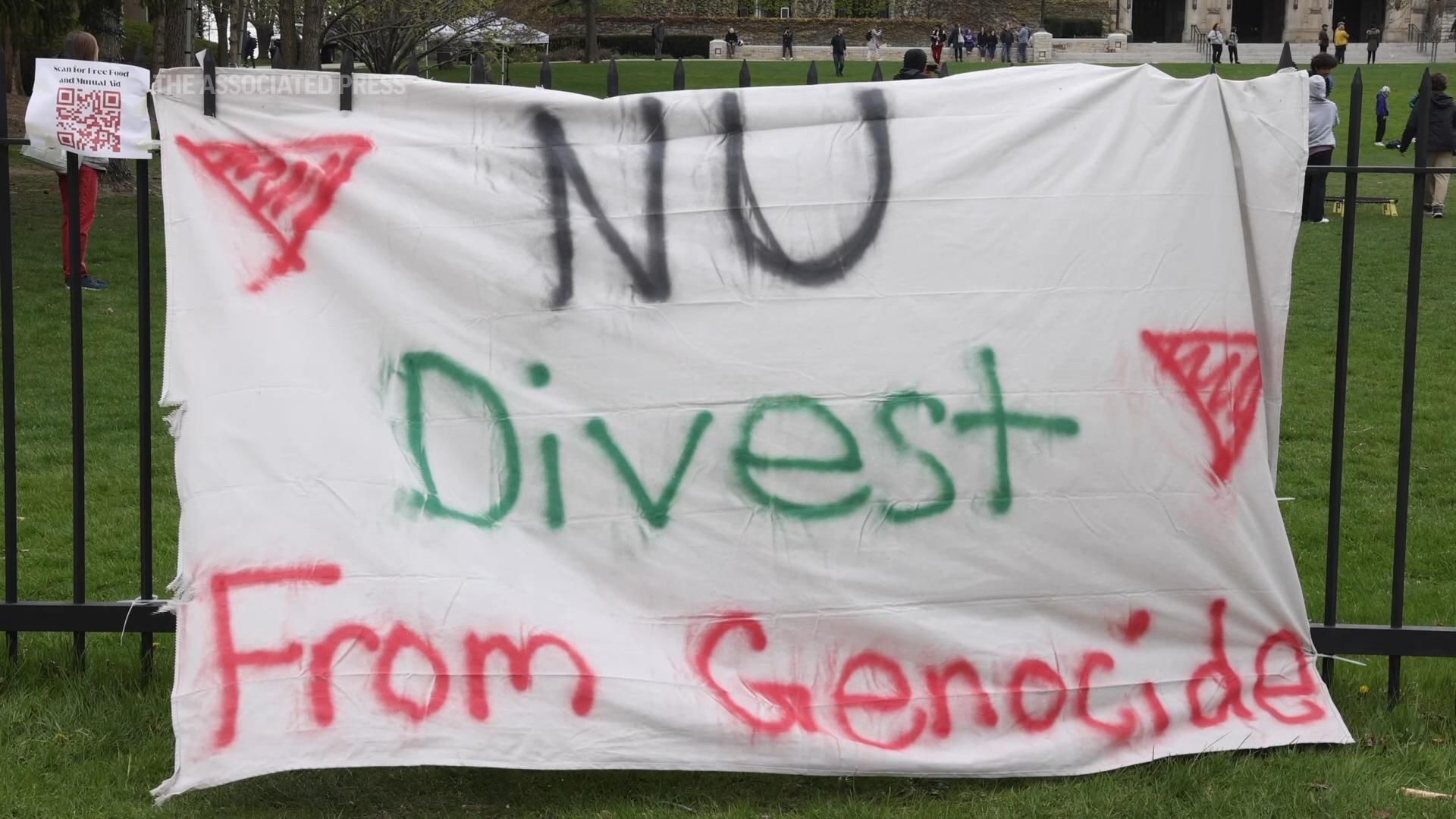Search Results
News about Squad, Columbia University, primary challenges
News about Israel, UNRWA, Hamas
News about US, Texas, universities
Israel, officially the State of Israel, is a country in the Southern Levant region of West Asia.It is bordered by Lebanon to the north, Syria to the northeast, Jordan to the east, the Red Sea to the south, Egypt to the southwest, the Mediterranean Sea to the west, and the Palestinian territories – the West Bank along the east and the Gaza Strip along the southwest.
Northwestern students set up pro-Palestinian encampment as university changes protest policy
Associated Press Videos33 minutes agoStudents at Northwestern University in Evanston, Illinois, have set up a tent encampment as student protests over the Israel-Hamas war have popped up on an increasing number of U.S. college campuses (AP Video:Teresa Crawford)
Up Next
- 01:09Northwestern students set up pro-Palestinian encampment as university changes protest policyAssociated Press VideosStudents at Northwestern University in Evanston, Illinois, have set up a tent encampment as student protests over the Israel-Hamas war have popped up on an increasing number of U.S. college campuses (AP Video:Teresa Crawford)33 minutes ago
- 01:07Egypt sending delegation to Israel in hope of reaching cease-fire agreement with Hamas; AP explainsAssociated Press VideosEgypt has sent a high-level delegation to Israel in the hope of reaching a cease-fire agreement with Hamas in Gaza. (April 26).5 hours ago
- 02:22Seniors who entered college in 2020 experiencing second wave of protests, turbulenceAssociated Press VideosStudents protesting the Israel-Hamas war are a part of a number of demonstrations roiling campuses from California to Massachusetts. While protests continue, students who are graduating this May were likely those who entered college in 2020 amidst the coronavirus pandemic and a summer of protests over the death of George Floyd. (April 26) (AP Video: Mark Vancleave)5 hours ago
- 00:50College tent encampments protest Israel-Hamas war in Evanston, Ill., Los Angeles and PhiladelphiaAssociated Press VideosStudent protests over the Israel-Hamas war have popped up on an increasing number of college campuses across the U.S., including tent encampments at Northwestern University, University of California and University of Pennsylvania.5 hours ago
- 02:17Mother of Israeli-American hostage speaks about hope amid her son’s captivity by HamasCBS News VideosRachel Goldberg-Polin told her son Hersh to stay strong in recorded messages after Hamas released a propaganda video of the Israeli-American hostage in captivity. She also shared a message to the leaders of Israel and Hamas, urging them to reach a deal for the hostages' release.9 hours ago
- 02:52Campus protests rage across the nationABC News VideosABC News’ Stephanie Ramos reports on the growing amount of discord on college and university campuses across the U.S. amid the Israel-Hamas war.15 hours ago
- 02:08Mother of Israeli-American hostage shown in Hamas video urges son to stay strongCBS News VideosThe mother of Hersh Goldberg-Polin, an Israeli-American man who was taken hostage by Hamas militants in their Oct. 7 assault on Israel, spoke to CBS News Thursday about a video released Wednesday by Hamas that appears to show her son in captivity. Debora Patta has more.22 hours ago
- 02:36Hersh Goldberg-Polin's mother on Hamas video of son in captivityCBS News VideosA new video released by Hamas appears to show Hersh Goldberg-Polin, an Israeli-American hostage taken during the Oct. 7 attacks in Israel. His mother, Rachel Goldberg-Polin, tells CBS News' Debora Patta what it was like hearing her son's voice.24 hours ago
- 00:40Calmer University of Texas protest after police and state troopers made dozens of arrests day beforeAssociated Press VideosThe demonstration at the University of Texas in Austin was much calmer Thursday after the day before when law enforcement made dozens of arrests and forced hundreds of students off the school's main lawn during a protest over the Israel-Hamas war. (AP video: James Vertuno)1 day ago
 00:49Pro-Palestine college protests: USC latest campus with student arrestsUSA TODAYUniversity of Southern California students are the latest to be arrested as students across the country protest against the Israel-Hamas war.1 day ago
00:49Pro-Palestine college protests: USC latest campus with student arrestsUSA TODAYUniversity of Southern California students are the latest to be arrested as students across the country protest against the Israel-Hamas war.1 day ago- 03:00Campus protests spread across countryABC News VideosCalifornia, Texas, New York and Boston have all seen new waves of demonstrations amid the Israel-Hamas war, with up to 100 protestors arrested at Emerson College in Boston overnight.2 days ago
- 00:51Police arrest pro-Palestinians protesters LA campusReuters Videos
STORY: The protesters who surrendered peacefully to be arrested, joined students at several universities, including Columbia, Yale and New York University - that have taken part to protest Israel's military operations in Gaza in response to the deadly October 7th attacks by Hamas.
On many campuses, protesters have set up unauthorized tent encampments to press their demands.
Since Friday, hundreds of students and others have been arrested at Columbia, Yale and NYU, while critics, including prominent Republican members of the U.S. Congress, have stepped up accusations of antisemitism and harassment by at least some protesters.
2 days ago  01:19Hamas official says group would lay down its weapons if a two-state solution is implementedAssociated Press VideosA top Hamas political official told The Associated Press the Islamic militant group is willing to agree to a truce of five years or more with Israel and that it would lay down its weapons and convert into a political party if an independent Palestinian state is established along pre-1967 borders. The comments by Khalil al-Hayya in an interview Wednesday came amid a stalemate in months of cease-fire talks. (AP video and production by Mehmet Guzel)2 days ago
01:19Hamas official says group would lay down its weapons if a two-state solution is implementedAssociated Press VideosA top Hamas political official told The Associated Press the Islamic militant group is willing to agree to a truce of five years or more with Israel and that it would lay down its weapons and convert into a political party if an independent Palestinian state is established along pre-1967 borders. The comments by Khalil al-Hayya in an interview Wednesday came amid a stalemate in months of cease-fire talks. (AP video and production by Mehmet Guzel)2 days ago- 00:53Parents say 'stay strong' after seeing son in Hamas hostage videoReuters Videos
STORY: They called on all the countries involved in the negotiation between Israel and Hamas "seize this moment and get a deal done to reunite all of us with our loved ones and end the suffering in this region."
The short video, which is undated, showed the 23-year-old missing his lower arm, which was blown off during the Hamas-led attack in October, but otherwise apparently healthy.
His mother has been campaigning actively for the release of her son, who was abducted at the Nova music festival that was attacked by Hamas gunmen early on Oct. 7 and is one of 133 Israeli hostages still in captivity after more than 100 were released last year.
2 days ago - 02:32Eurovision host Sweden braces for anti-Israel protestsReuters Videos
STORY: The Swedish city of Malmo is gearing up to host the Eurovision Song Contest against a backdrop of heightened security and planned protests over Israel’s participation.
Eurovision is the biggest contest of its kind in the world.
Two hundred million people are expected to tune in.
And about 100,000 are expected to travel to Sweden’s third-largest city.
Earlier this month, protesters denounced Israel’s participation in a protest outside Malmo’s City Hall.
And multiple large pro-Palestinian protests are planned outside the contest venue.
Protest signs are already up around the city.
Malmo resident Orwa Kadoura is a Palestinian who is helping to organize protests.
The feelings around Israel’s participation, he says, are difficult and multi-layered, including anger, sadness and a feeling of injustice.
The European Broadcasting Union — or EBU — organizes the contest.
It’s resisted calls for Israel to be excluded over the war in Gaza and says the event is non-political.
Still, the EBU banned Russia in 2022 after several European public broadcasters called for the country to be expelled over its invasion of Ukraine.
This time around, Israeli contestant Eden Golan will be under the spotlight, along with her song, “Hurricane.”
Israel got the green light to compete after agreeing to modify the lyrics of its original song, “October Rain,” which the EBU said made reference to the October 7 Hamas onslaught in Israel.
Organizers face the risk of protests escalating into violence, heightened terror threats in the country, as well as increased tensions with Russia after Sweden's NATO membership.
Police say security will be tighter compared to the last time Sweden hosted the event in 2016.
The contest’s executive producer Ebba Adielsson says her focus is on the visitors coming to Sweden from over 80 countries.
“This is my focus and I really hope that people will feel this and be united by music."
Those visitors will have to pass through airport-like security checks when entering venues.
The contest takes place from May 7 to 11.
2 days ago - 03:42Protests around college campuses lead to arrests, shutdownsABC News VideosAs dozens more are arrested in college protests over the Israel-Hamas war, White House Press Secretary Karine Jean-Pierre shares the opinion of the Biden administration.2 days ago
- 01:36Germany to resume funding UNRWA Palestinian agencyReuters Videos
STORY: Germany plans to resume funding of the UN Palestinian agency, or UNRWA.
That's according to a statement from the country’s foreign and development ministries on Wednesday (April 24).
Earlier this year, Israel accused hundreds of UNRWA staff of being military operatives in so-called terrorist groups in Gaza.
A number of countries including the U.S. and Britain then paused payments to UNRWA, a severe blow to the agency that provides education, health and aid to millions of Palestinians in Gaza, the West Bank, Jordan, Lebanon and Syria.
But a new report released on Monday concluded that Israel had not provided enough evidence to back up its claims.
The review was led by former French foreign minister Catherine Colonna, looking into UNRWA’s ability to ensure neutrality.
"Overall, the findings of the review are that UNRWA has in place a very significant number of mechanisms and procedures to ensure compliance with the humanitarian principle of neutrality.”
A separate UN probe is also investigating Israel’s accusation that 12 UNRWA staff took part in the Hamas-led October 7 attacks.
Norway, which is a major donor to UNRWA, on Tuesday called on donors to resume funding, arguing that the donation cuts have put the population of Gaza at risk.
Ten countries have resumed their donation following the review.
The U.S., UK, Italy, the Netherlands, Austria, and Lithuania have not yet done so.
A U.N. spokesperson on Monday said UNRWA currently only had enough funding to pay for operations until June.
2 days ago - 00:47Gaza Strip could reach famine in six weeks, WFP saysReuters Videos
STORY: "We are getting closer by the day to a famine situation," said Gian Carlo Cirri, Geneva director of the WFP.
A U.N.-backed report published in March said that famine was imminent and likely to occur by May in northern Gaza and could spread across the enclave by July. On Tuesday, a U.S. official said the risk of famine in Gaza, especially in the north, was very high.
Cirri was speaking at the launch of a report by the Global Network Against Food Crises, an alliance of humanitarian and development actors including United Nations agencies, the World Bank, the European Union and the United States.
In its report, the network described the 2024 outlook for the Middle East and Africa as extremely concerning due to the Gaza war and restricted humanitarian access, as well as the risk of the conflict spreading elsewhere in the region.
The United Nations has long complained of obstacles to getting aid in and distributing it throughout Gaza in the six months since Israel began an aerial and ground offensive against Gaza's ruling Islamist militant group Hamas.
Israel has denied hindering supplies of humanitarian aid and blames aid agencies for inefficiencies in distribution.
2 days ago - 02:23Universities move classes online as protests escalateABC News VideosNYU ramped up security after clashes with police and Cal Poly Humboldt closed the campus after protests turned violent as demonstrations about the Israel-Hamas war continue across the country.3 days ago
- 02:23Pro-Palestinian protests spread to more US schoolsReuters Videos
STORY: Pro-Palestinian student protests expanded to more U.S. college campuses on Tuesday, after mass arrests at demonstrations among a handful of mostly East Coast schools in recent days.
They're all responding to Israel’s war in Gaza, launched after a deadly October raid by Hamas Islamist militants.
At University of California Berkeley – a school with a strong legacy of student activism– students erected a tent camp on Tuesday in solidarity with protesters at other schools.
The demonstrations coincide with the week-long Jewish feast of Passover.
“I’m here especially on the first day of Passover because I believe that in this moment where we celebrate the liberation of our people it is important to fight for the liberation of others.”
The campus of Cal Poly Humboldt, a public university also in California, was shut down after pro-Palestinian protesters occupied a campus building.
And at the University of Minnesota campus in St. Paul, police cleared an encampment after the school asked them to take action, citing violations of university policy and trespassing law.
The new protests follow the arrest of more than 100 students at Columbia last week, and around 120 protesters on New York University's campus late Monday.
NYPD said university authorities reached out for help, and protesters failed to clear by the deadline given by the university.
New York Mayor Eric Adams on Wednesday defended the actions of police, and also said that outside agitators had infiltrated the demonstrations.
“We have identified individuals who don't attend the schools, who are on the campuses.”
“They latch on to any protests to see our police officers having bottles thrown at them.”
Adams joined in with Columbia administrators, state officials, some members of Congress and the White House in citing incidents of extreme rhetoric by Pro-Palestinian protesters, and allegations that Jewish students have been subjected to antisemitism and harassment.
While student organizers from Columbia have acknowledged several such incidents, they maintain that quote "inflammatory individuals" do not represent their anti-war movement.
The White House has said it is closely monitoring the situation on college campuses.
3 days ago - 00:49Columbia University students return for in-person classesReuters Videos
STORY: The school canceled in-person classes on Monday (April 22) in response to protesters setting up tent encampments at its New York City campus last week.
Protests at Yale University, Columbia, New York University and other university campuses across the nation began in response to the escalation of the Israeli-Palestinian conflict, following the deadly cross-border raid by Hamas militants on Oct. 7 and Israel's fierce response in the Gaza enclave controlled by Hamas.
In an email to Columbia staff and students on Monday, Columbia President Nemat Minouche Shafik said the university was canceling in-person classes and moving to online teaching to "deescalate the rancor and give us all a chance to consider next steps."
Last week, Shafik called in New York police to clear a tent encampment protesters had set up on Columbia's main lawn to demand the school divest from Israel-related investments, an unusual move condemned by some faculty.
The school said the encampment violated rules. Police arrested more than 100 students from Columbia on Thursday (April 18) on charges of trespassing. Columbia and the affiliated Barnard College have suspended dozens of students involved in the protests.
3 days ago - 01:29AP explains: 200 days of Israel-Hamas war in the Gaza StripAssociated Press VideosAP explains: 200 days of Israel-Hamas war in the Gaza Strip3 days ago
- 02:22Pro-Palestinian Protests Escalate at Columbia, NYU and Other SchoolsWSJUniversity leaders struggled to contain pro-Palestinian protests on campus as tensions over the Israel-Hamas war intensified. Photo: Sarah Blesener for the Wall Street Journal3 days ago
 01:18Dozens arrested at NYU pro-Palestinian protestAssociated Press VideosStudents protests over Israel's war with Hamas have been spreading in New York and nationwide, with police taking 133 protesters into custody late Monday after a protest at New York University. (AP video: Noreen Nasir/Production: Vanessa A. Alvarez)3 days ago
01:18Dozens arrested at NYU pro-Palestinian protestAssociated Press VideosStudents protests over Israel's war with Hamas have been spreading in New York and nationwide, with police taking 133 protesters into custody late Monday after a protest at New York University. (AP video: Noreen Nasir/Production: Vanessa A. Alvarez)3 days ago- 01:11UN rights chief 'horrified' by Gaza mass grave reportsReuters Videos
STORY: Palestinian authorities reported finding scores of bodies in mass graves at Nasser hospital in Khan Younis this week after it was abandoned by Israeli troops. Bodies were also reported at the Al Shifa site following an Israeli special forces operation.
"We feel the need to raise the alarm because clearly there have been multiple bodies discovered," said Shamdasani, adding Turk said he had been horrified by the reported mass grave discoveries and the hospitals' destruction.
"Some of them had their hands tied, which of course indicates serious violations of international human rights law and international humanitarian law, and these need to be subjected to further investigations."
She added that the U.N. human rights office was working on corroborating Palestinian officials' reports that 283 bodies were found at Nasser and 30 at Al Shifa.
Gaza's Hamas-run Civil Emergency Service said on Tuesday that a total of 310 bodies had been found at one mass grave at Nasser so far and that two other graves had been identified, but not yet excavated.
Israel's military and its diplomatic mission in Geneva were not immediately available for comment on the Jewish Passover holiday. Israel says Hamas militants use hospitals as bases and that its forces killed around 200 militants at Al Shifa and avoided harming any civilians.
3 days ago
People also ask
- Overview
- Relief
- Drainage
- Soils
Israel, country in the Middle East, located at the eastern end of the Mediterranean Sea. It is bounded to the north by Lebanon, to the northeast by Syria, to the east and southeast by Jordan, to the southwest by Egypt, and to the west by the Mediterranean Sea. Jerusalem is the seat of government and the proclaimed capital, although the latter status has not received wide international recognition.
Israel is a small country with a relatively diverse topography, consisting of a lengthy coastal plain, highlands in the north and central regions, and the Negev desert in the south. Running the length of the country from north to south along its eastern border is the northern terminus of the Great Rift Valley.
The State of Israel is the only Jewish nation in the modern period, and the region that now falls within its borders has a lengthy and rich history that dates from prebiblical times. The area was a part of the Roman Empire and, later, the Byzantine Empire before falling under the control of the fledgling Islamic caliphate in the 7th century ce. Although the object of dispute during the Crusades, the region, then generally known as Palestine, remained under the sway of successive Islamic dynasties until the collapse of the Ottoman Empire at the end of World War I, when it was placed under British mandate from the League of Nations.
Even before the mandate, the desire for a Jewish homeland prompted a small number of Jews to immigrate to Palestine, a migration that grew dramatically during the second quarter of the 20th century with the increased persecution of Jews worldwide and subsequent Holocaust perpetrated by Nazi Germany. This vast influx of Jewish immigrants into the region, however, caused tension with the native Palestinian Arabs, and violence flared between the two groups leading up to the United Nations plan to partition Palestine into Jewish and Arab sectors and Israel’s ensuing declaration of statehood on May 14, 1948.
Britannica Quiz
Countries of the World
Despite its small size, about 290 miles (470 km) north-to-south and 85 miles (135 km) east-to-west at its widest point, Israel has four geographic regions—the Mediterranean coastal plain, the hill regions of northern and central Israel, the Great Rift Valley, and the Negev—and a wide range of unique physical features and microclimates.
Are you a student? Get Britannica Premium for only 24.95 - a 67% discount!
Learn More
The coastal plain is a narrow strip about 115 miles (185 km) long that widens to about 25 miles (40 km) in the south. A sandy shoreline with many beaches borders the Mediterranean coast. Inland to the east, fertile farmland is giving way to growing agricultural settlements and the cities of Tel Aviv and Haifa and their suburbs.
In the north of the country, the mountains of Galilee constitute the highest part of Israel, reaching an elevation of 3,963 feet (1,208 metres) at Mount Meron (Arabic: Jebel Jarmaq). These mountains terminate to the east in an escarpment overlooking the Great Rift Valley. The mountains of Galilee are separated from the hills of the Israeli-occupied West Bank to the south by the fertile Plain of Esdraelon (Hebrew: ʿEmeq Yizreʿel), which, running approximately northwest to southeast, connects the coastal plain with the Great Rift Valley. The Mount Carmel range, which culminates in a peak 1,791 feet (546 metres) high, forms a spur reaching northwest from the highlands of the West Bank, cutting almost to the coast of Haifa.
The Great Rift Valley, a long fissure in Earth’s crust, begins beyond the northern frontier of Israel and forms a series of valleys running generally south, the length of the country, to the Gulf of Aqaba. The Jordan River, which marks part of the frontier between Israel and Jordan, flows southward through the rift from Dan on Israel’s northern frontier, where it is 500 feet (152 metres) above sea level, first into the Ḥula Valley (Hebrew: ʿEmeq HaḤula), then into the freshwater Lake Tiberias, also known as the Sea of Galilee (Hebrew: Yam Kinneret), which lies 686 feet (209 metres) below sea level. The Jordan continues south along the eastern edge of the West Bank—now through the Jordan Valley (Hebrew: ʿEmeq HaYarden)—and finally into the highly saline Dead Sea, which, at 1,312 feet (400 metres) below sea level, is the lowest point of a natural landscape feature on the Earth’s surface. South of the Dead Sea, the Jordan continues through the rift, where it now forms the ʿArava Valley (Hebrew: “savannah”), an arid plain that extends to the Red Sea port of Eilat.
The principal drainage system comprises Lake Tiberias and the Jordan River. Other rivers in Israel are the Yarqon, which empties into the Mediterranean near Tel Aviv; the Qishon, which runs through the western part of the Plain of Esdraelon to drain into the Mediterranean at Haifa; and a small section of the Yarmūk, a tributary of the Jordan that f...
The coastal plain is covered mainly by alluvial soils. Parts of the arid northern Negev, where soil development would not be expected, have windblown loess soils because of proximity to the coastal plain. The soils of Galilee change from calcareous rock in the coastal plain, to Cenomanian and Turonian limestone (deposited from about 99 to 89 millio...
Get the latest updates on the ongoing conflict between Israel and Hamas in Gaza, the political crisis over the draft law, and other stories from the region and the Jewish world. Read analysis, opinion, and features from The Times of Israel staff and contributors.
- April 14th and the Dangers of Nuclear Iran
- Sheryl Sandberg’s new film testifies to Hamas’s brutal sexual violence on October 7
- Lessons from Iran-Israel clash: conceptions & coalitions
- Hundreds of students arrested from Texas to California as college Israel protests continue
- Blinken calls US campus protests a hallmark of democracy, but decries ‘silence’ on Hamas
- Egypt’s spy chief in Israel for talks on hostage deal amid concerns over Rafah op
- Hats off for the Israel Defense Forces
- Columbia drops midnight deadline for razing anti-Israel camp as 550 arrested across US
- Israel-Gaza War 5784: Acharei Mot – Admitting Error, Rejecting Molech
- Israel said willing to accept release of fewer than 40 hostages in truce’s first phase
e. The history of Israel covers an area of the Southern Levant also known as Canaan, Palestine or the Holy Land, which is the geographical location of the modern states of Israel and Palestine. From a prehistory as part of the critical Levantine corridor, which witnessed waves of early humans out of Africa, to the emergence of Natufian culture ...
The State of Israel was proclaimed in 1948, and Egypt, Transjordan (later Jordan), Syria, Lebanon, and Iraq immediately declared war on it. Israel won that war ( see Arab-Israeli wars) as well as the 1967 Six-Day War, in which it occupied the West Bank, Gaza Strip, Golan Heights, and east Jerusalem.
DictionaryIs·ra·el/ˈizrēəl/- 1. the Hebrew nation or people. According to tradition, they are descended from the patriarch Jacob (also named Israel), whose twelve sons became founders of the twelve tribes of ancient Israel.
- 2. the northern kingdom of the Hebrews (c. 930–721 bc), formed after the reign of Solomon, whose inhabitants were carried away to captivity in Assyria.
Apr 15, 2024 · A comprehensive overview of Israel's geography, history, politics, economy, and society. Learn about Israel's location, climate, natural resources, population, conflicts, and achievements.
- Israel
Country in Middle East
Israel, officially the State of Israel, is a country in the Southern Levant region of West Asia. It is bordered by Lebanon to the north, Syria to the northeast, Jordan to the east, the Red Sea to the south, Egypt to the southwest, the Mediterranean Sea to the west, and the Palestinian territories – the West Bank along the east and the Gaza Strip along the southwest. Wikipedia
- Israeli new shekel (ILS)
- 9.2 million
- $553 billion (2024)
- 25 (2022)
Credit: Getty ImagesFeedback See results about
Trending Now































